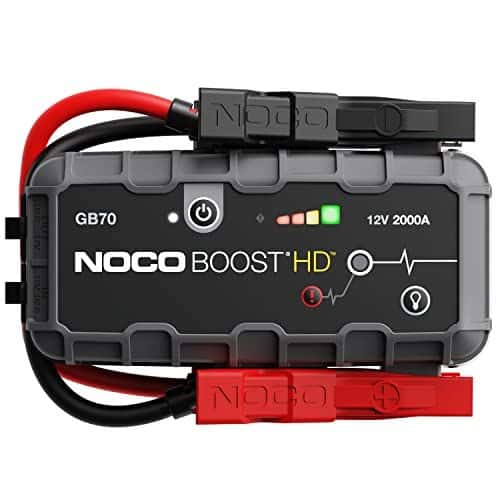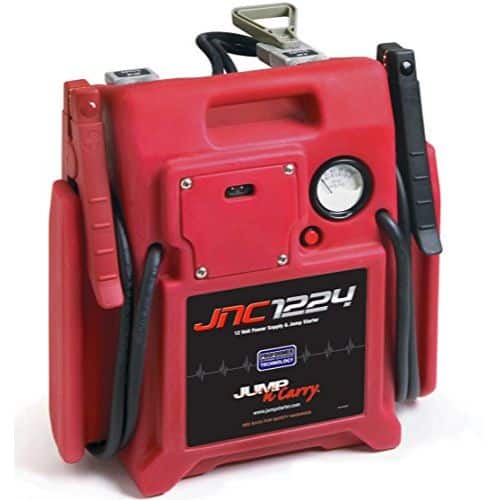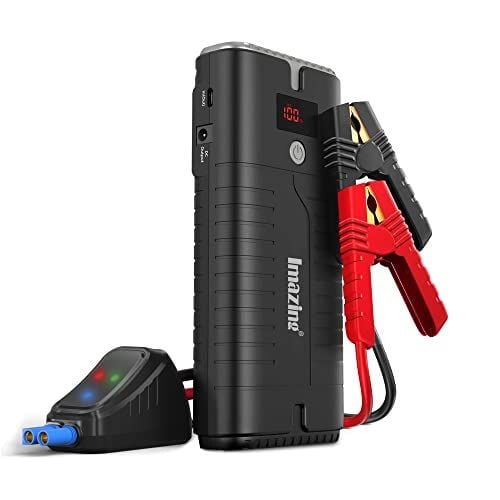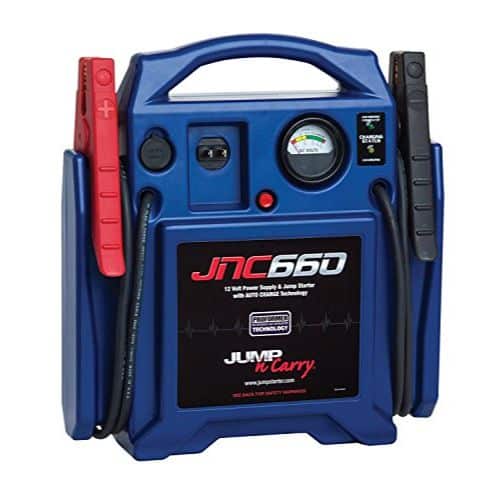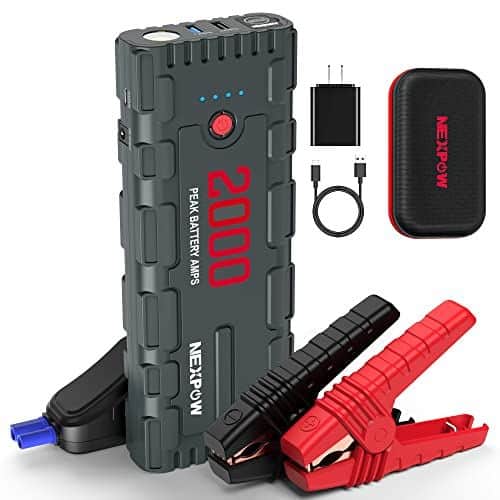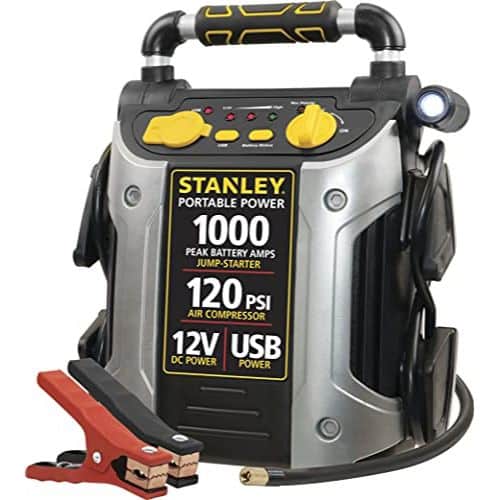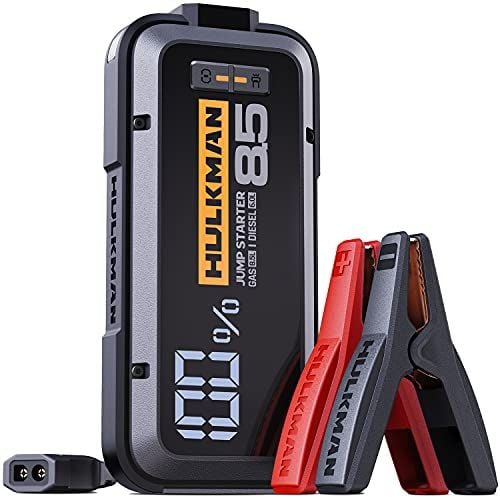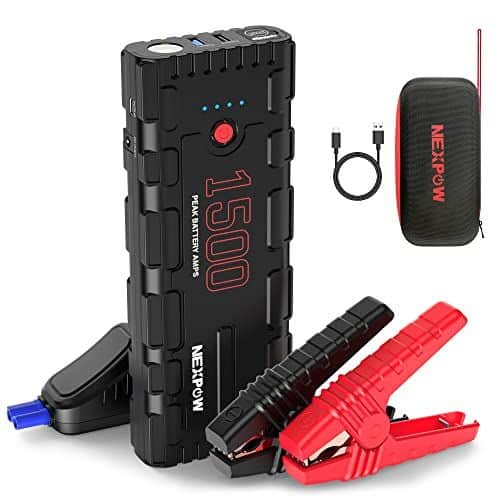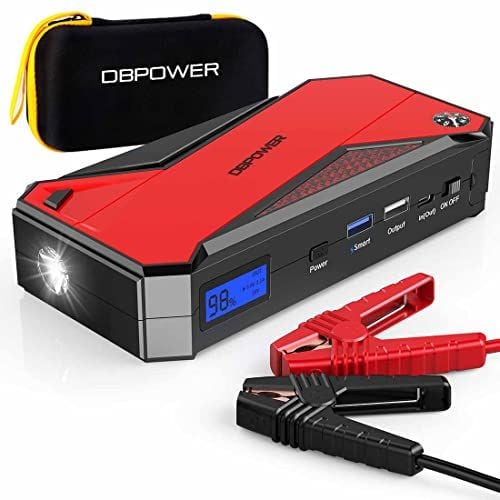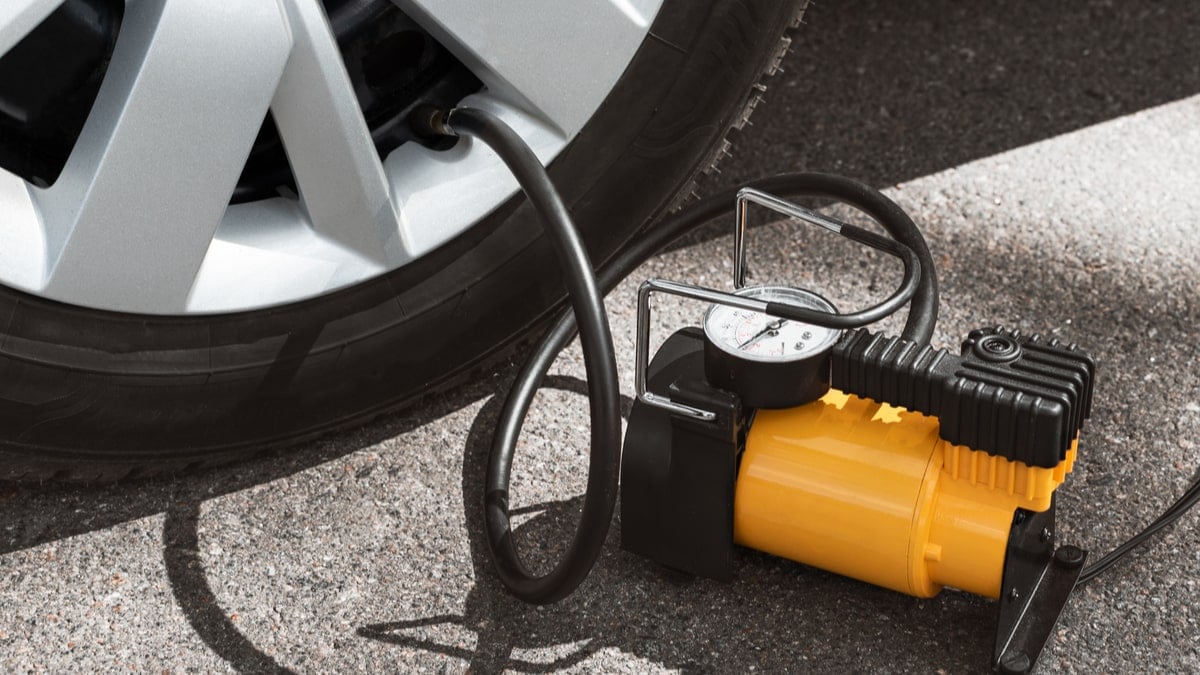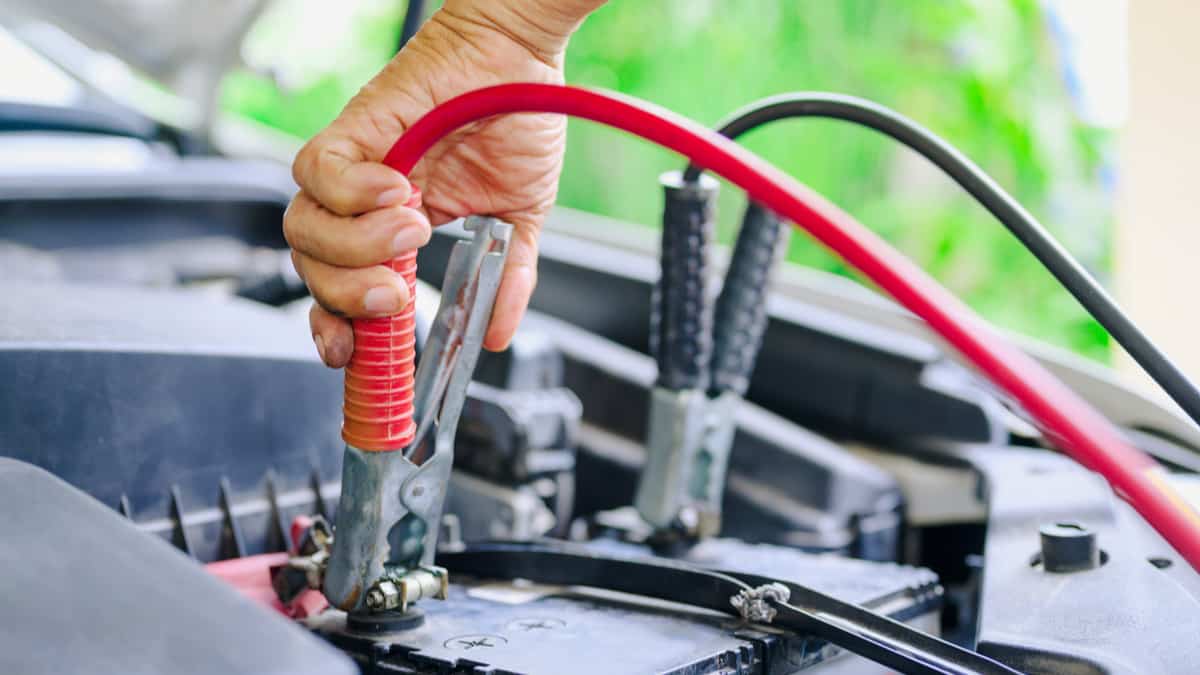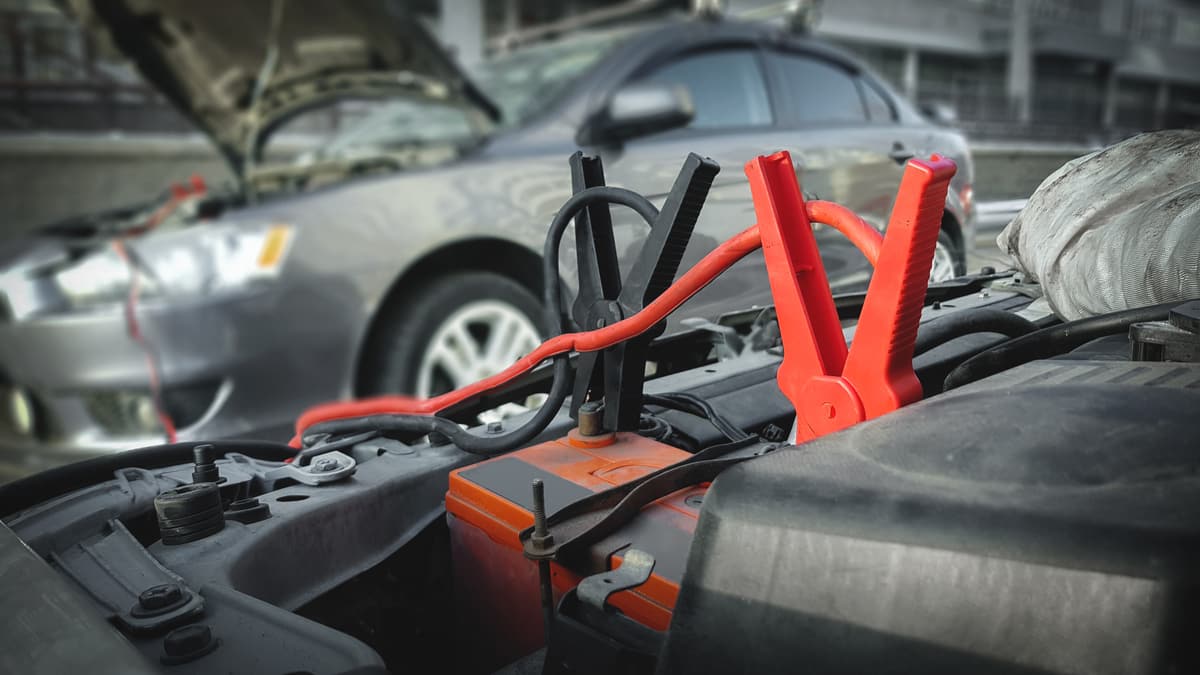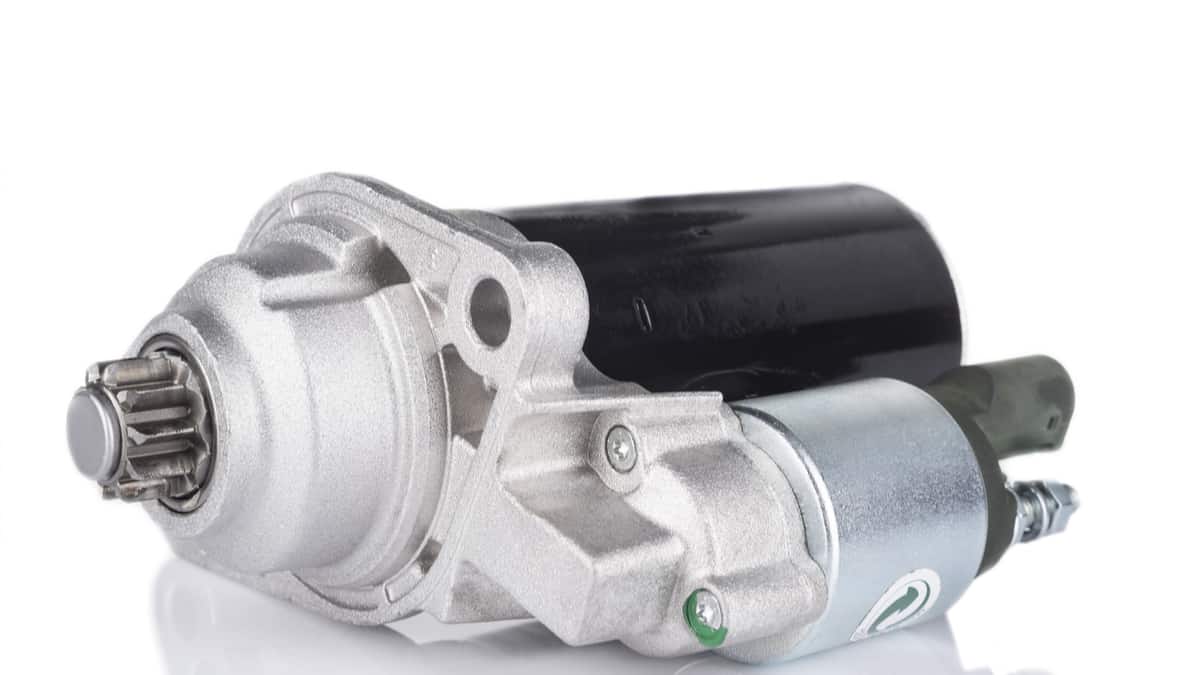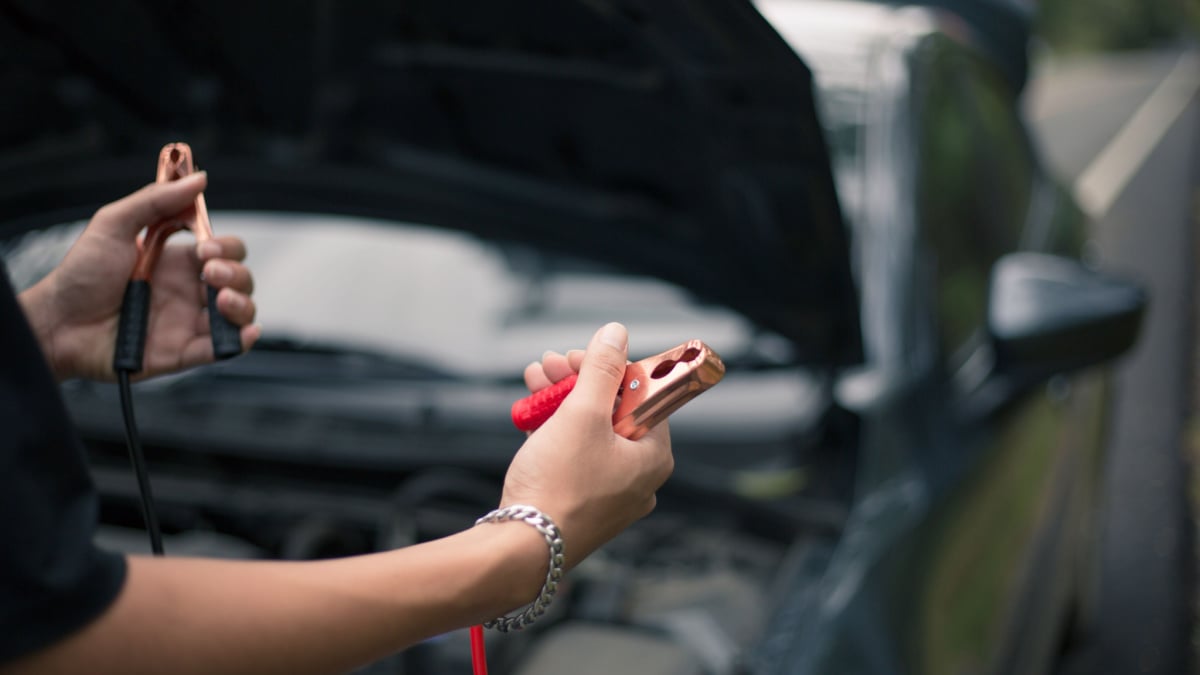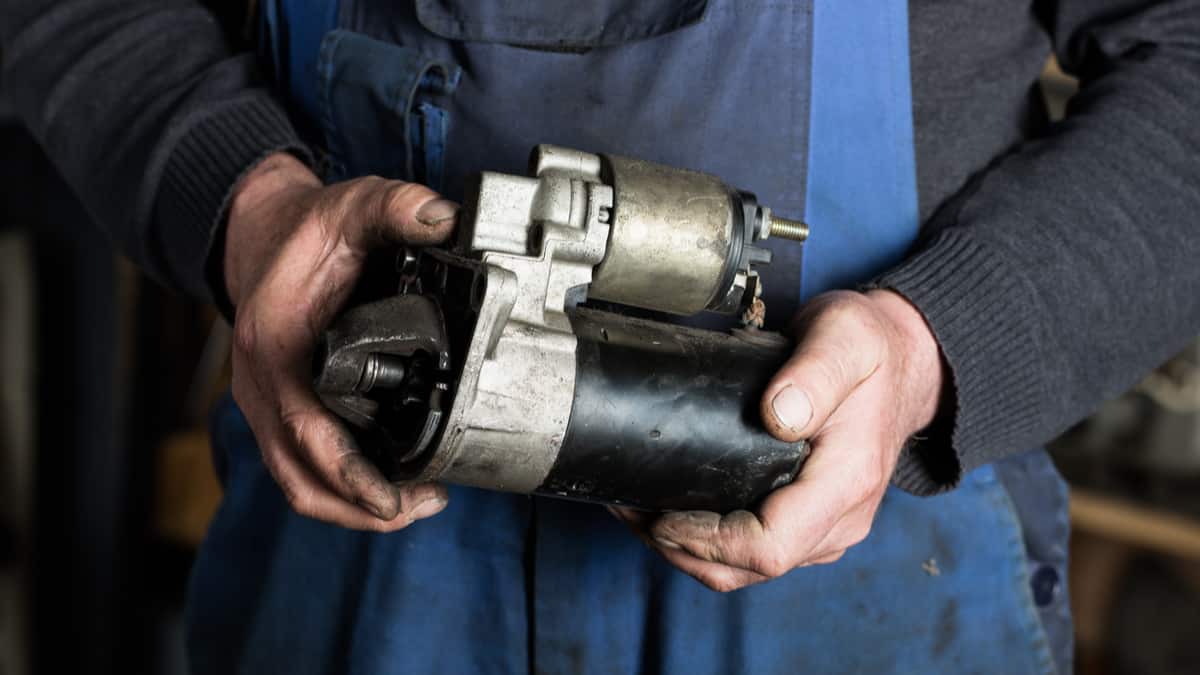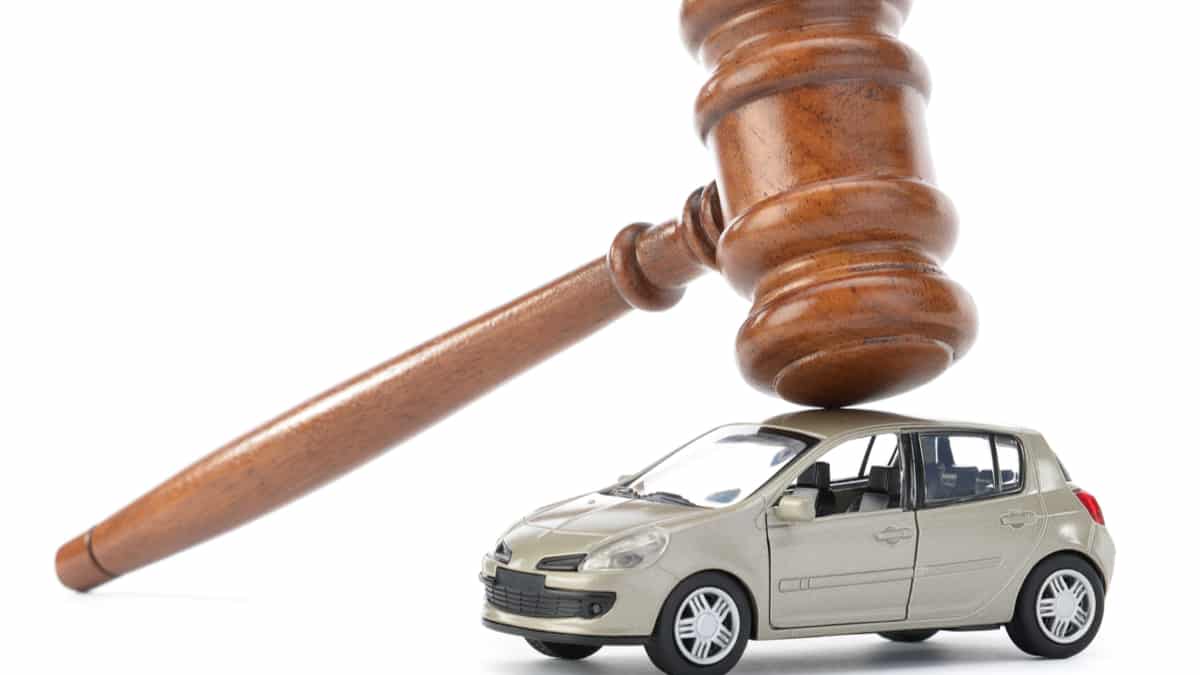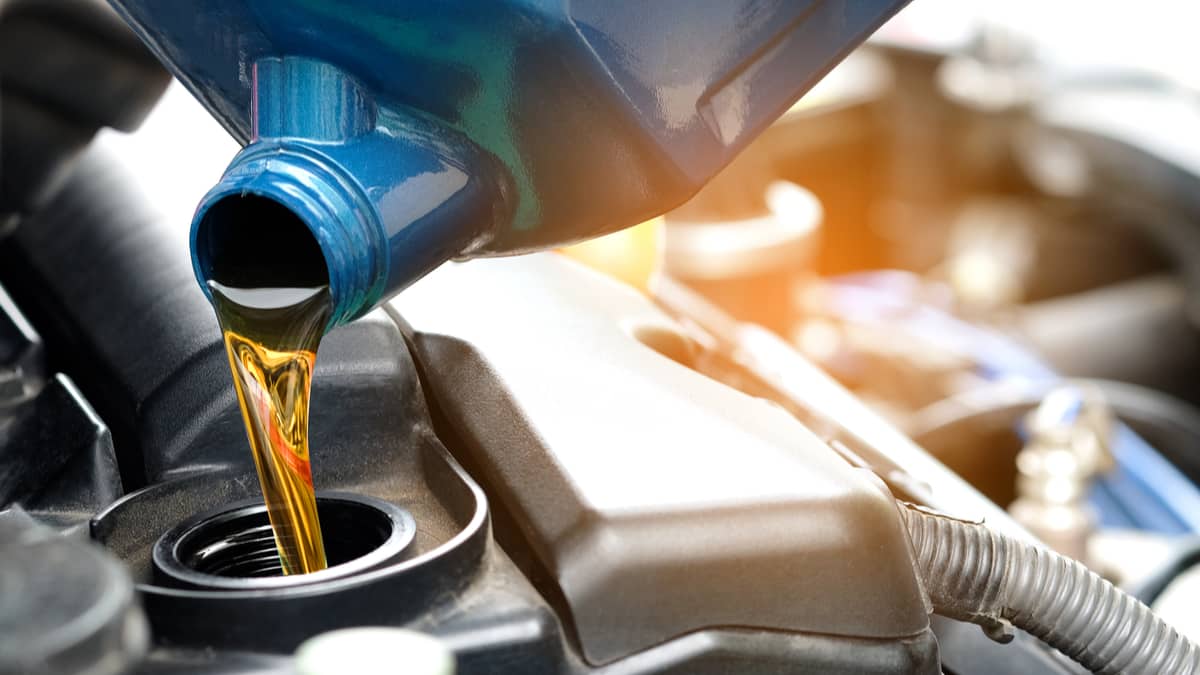There’s nothing that will ruin a road trip or even a trip to the grocery store faster than a dead battery. And while a set of jumper cables can be a good investment, if you don’t have someone around that’s willing to help you out, you’ll still be out of luck.
That’s where a portable jump starter comes in. But while there are tons of portable jump starters out there, not all of them will do what they promise. That’s why we took the time to track down and review the best jump starters on the market.
With the right portable jump starter, you can get your car or truck started back up and get on the road in no time – turning that crisis into nothing more than a minor inconvenience. These are the ten best portable jump starters to do just that.
10 Best Portable Jump Starters
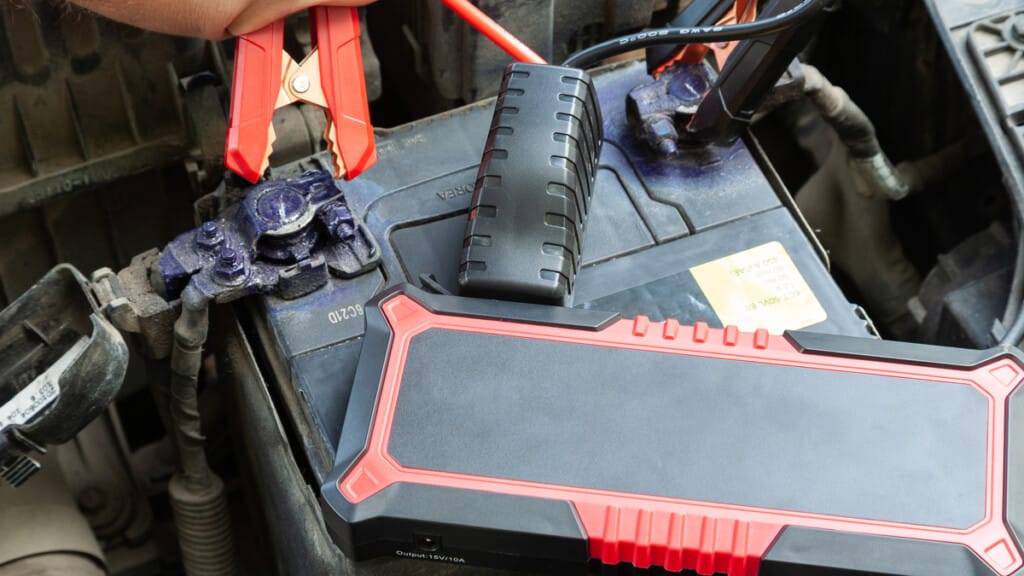
1. NOCO Boost HD GB70 – Best Jump Starter Overall
Amps – 2,000
NOCO makes two different portable jump starters that made our list, but the Boost HD GB70 is the better and more powerful of the two. This compact jump starter pushes out an impressive 2,000 amps which are more than enough to jump any car and just about any truck.
Not only does it have tons of amps for starting cars, but it also has USB ports to charge mobile devices and a 400 lumen LED light that can brighten up any situation. Moreover, the jump starter itself charges extremely fast and has reverse polarity protection that prevents you from accidentally frying the system.
However, for everything this compact jump starter does right, there is one thing to consider – the price. This jump starter costs between two to three times as much as some of the other compact jump starters, which is a pretty big deal.
It’s one of the best choices when it comes to jump starters if you’re willing to spend this much money, but if you’re spending this much, you should check out the next jump starter from NOCO.
Pros
- Reverse polarity protection
- Tons of amps to start any car
- It has a USB charge port
- 400 lumen LED flashlight is extremely bright
- It charges extremely fast
- 1-year warranty
Cons
- More expensive option
- It does not come with a wall outlet charger
2. NOCO Boost Plus GB40 – Great Value
Amps – 1,000
While the NOCO Boost Plus GB40 might not be as powerful as the Boost HD GB70, it’s still more than enough for most cars and SUVs. It’s also not nearly as expensive as the Boost HD.
It has USB outlets to charge mobile devices and an LED flashlight. It does have reverse polarity protection though, which means you don’t have to worry about frying the system if you hook the clamps up backward.
Not only that, but it’s an extremely compact jump starter which makes it easy to add to any toolbox or even store in the glove box of your car on your next trip.
Finally, it has a one-year warranty which helps offset the slightly higher cost – even if the one-year warranty is only half of what many other companies offer.
If this is the choice your go with you won’t be left disappointed.
Pros
- Reverse polarity protection
- It has USB outlets
- One year warranty
- Ultra-compact design
- It has an LED flashlight
Cons
- Half the amps as the Boost HD
3. Jump-N-Carry JNC1224 – Best for Professionals
Amps – 3,400
If you’re getting equipment for a mobile maintenance truck, you don’t have time for smaller jump packs that get the job done eventually or those that can’t handle larger vehicles. With the Jump-N-Carry JNC1224, you can get to the job site and move on faster than ever.
It’s a jump pack with an impressive 3,400 amps that you can use to start any vehicle, no matter how big or small. Even better for those working with commercial vehicles, you can quickly switch from a 12-volt option to a 24-volt one, so one jump pack can conquer any vehicle you come across.
As every good mechanic knows, the amps will only take you so far if you don’t have the right gauge wire, and here the jump pack doesn’t disappoint either. It has #2-gauge cables, which is more than enough for a jump pack.
Now it’s a commercial portable jump starter, which means it comes with a higher price tag too. This jump starter isn’t cheap, but the money you’ll make from getting in and out of job sites quickly will pay for itself in no time.
The most significant concern for many mechanics, especially older ones, is the weight. At 40-pounds, it’s not the heaviest portable jump starter out there, but it’s not light either. If you have a downed vehicle well off the beaten path and need to lug the jump starter down there, it can be a tiring experience.
The entire jump starter is in an extremely durable housing, so you don’t need to worry about breaking the system from accidental drops or falls. It’s the perfect addition to any mobile maintenance truck and will bail you out time and time again.
Pros
- Large #2 gauge starting cables
- Impressive 3,400 amps of power
- Both a 12V and 24V jump starter
- Extremely durable casing
Cons
- Heavier option at 40 pounds
- More expensive option
4. Imazing Portable Car Jump Starter – Best Budget
Amps – 2,000
Just because you want to play it safe with a portable car jump starter in your vehicle doesn’t mean you want to break the bank to do it. With the Imazing Portable Car Jump Starter, you don’t have to. It’s an extremely small and compact portable car jump starter available for an amazing price.
But don’t let its small size fool you, this portable car jump starter packs a punch with the ability to push out 2,000 peak amps. Not only does it have the ability to start almost any vehicle, but it also has a USB charge port that allows you to use the compact device to charge mobile electronic devices and other 12 volt accessories.
Additionally, it has reverse polarity protection and a two-year warranty, so you don’t need to worry about accidentally frying this system or having it fail on you when you need it.
However, this is a budget portable car jump starter, and nothing reflects this more than its ability to hold a charge. This device can only hold a charge high enough to jump your vehicle for a week or two at a time which can lead to problems.
So, if you’re looking to use this device as a backup system for your car, you’ll likely find it’s dead when you need it. But if you’re using the USB charging features and keeping up with the jump starters battery, it can make the perfect addition to keep you on the road.
Pros
- Available for a great price
- It has a ton of amps
- Small and compact design
- It has a USB-C charge port
- Reverse polarity protection
- It has a two-year warranty
Cons
- It does not hold a charge very long
5. Clore Automotive Jump-N-Carry JNC660 – Best Heavy Duty
Amps – 1,700
If you’re looking for a device that’s similar to the Jump-N-Carry JNC1224 but don’t want to deal with the commercial price tag, the Clore Automotive Jump-N-Carry is a nice alternative. The 1,700 peak amps is a bit lower, but it’s still more than enough for sedans, SUVs, and even large diesel engines!
It also utilizes #2-gauge jumper cables which means you get more out of each amp – which lets you bring even more batteries back. While this jump starter doesn’t have a ton of features, there are a few that make it easier to use.
First, it has built-in smart charging mode that allows it to stay fully charged without overloading the system. You can leave it plugged in until you’re ready to use it. But keep in mind that it’s a 110-volt charger and it can’t tolerate higher temperatures for extended periods.
This means you should keep it in a temperature-controlled setting and that storing it in your trunk for emergencies is a bad idea.
Another perk this jump starter offers is the easy-to-see and read voltmeter that allows you to quickly check the charge voltage before you head out. You don’t need to make assumptions about the charge, with the click of a button, you know right where you stand.
Still, it’s not very compact, and since you shouldn’t store it in your trunk, it’s not good for emergencies. It’s not compact, even if it is portable.
It’s an excellent heavy-duty jump starter, but it certainly has far more limited practical applications.
Pros
- #2-gauge jumper cables
- Heavy duty case adds to the overall durability
- Voltmeter lets you easily check the charge
- Good mix of price and performance
- Easy to charge and use
Cons
- Heavier options – and not as compact
- More basic design
6. NEX POW Car Jump Starter – Great Compact Jump Starter
Amps – 2,000
If you’re looking for a small yet powerful compact jump starter, the NEX POW Car Jump Starter is a phenomenal choice. Not only is it small and powerful, but it’s also available for a great price!
When you combine these factors with the fact that it has two separate USB charge ports, a built-in LED strobe, and reversed polarity protection, it’s not hard to see why it made our list. Sure, the jump cable adapter loses some of the effective amps, but with 2,000 peak amps, that’s not a problem.
The bigger concern is that it takes forever to charge this device with typical chargers. It uses a USB Type-C charging cable, which means it has a slow trickle charge setup. However, if you have a control board that lets you control the overall amps for each device, you can circumvent the longer charge time.
But even if you don’t, as long as you leave this device plugged in overnight before your trip, that’s more than enough time to get a full charge before you head out! And if you don’t need to jump-start your car, you can keep all your cell phones and tablets fully charged throughout your entire trip.
Pros
- Very compact design
- Very affordable price
- Two USB charge ports
- Reverse polarity protection
- It has a built-in LED strobe light
Cons
- Jumper cable adapter loses some amps
- It takes a long time to charge
7. STANLEY J5C09
Amps – 1,000
While the Stanley J5CO9 might not have the most power compared to some of the other jump-starter packs out there, it’s more than enough to jump most cars, SUVs, and compact trucks. And when you add in all the other features it provides, it quickly turns itself into the best portable jump starter on the market.
Not only does it have a 1,000 amp jump starter, but it also has a 120 PSI air compressor, USB charging ports, and reverse polarity protection. It’s the ultimate road trip crisis prevention tool and can bail you out of dead batteries and flat tires alike!
Not only that, but the entire assembly comes with a one-year warranty from a brand you can trust, and it has reverse polarity protection which means you won’t accidentally fry the system if you don’t know what you’re doing.
Just keep in mind that if you drive a large diesel-powered vehicle or a larger truck, the 1,000 amps of peak power might not be enough to jump a completely dead battery. Finally, while charging the Stanley J5CO9 is easy, know that it doesn’t come with a charging cord.
You’ll need a regular extension cord to plug into a wall outlet to charge the jump pack, which can be a bit disappointing and frustrating if you don’t realize this when you’re making your purchase.
Still, with everything this jump starter offers, and at this price, it’s not hard to see why it’s one of our top choices.
Pros
- It has a 120 PSI air compressor
- An outstanding mix of price and performance
- 1,000 amps are more than enough for most vehicles
- 12V DC output
- It has USB charging ports
- Reverse polarity protection
- It has a one-year warranty
Cons
- It doesn’t come with a charging cord
- Can’t jump-start larger vehicles
8. HULKMAN Alpha85
Amps – 2,000
Another compact car jump starter you should consider is this HULKMAN Alpha 85. It’s powerful enough to jump just about any vehicle, as long as the batteries are not too far gone.
The jump starter itself has a lighting fast charging time going from dead to full charge in just an hour and a half, and the digital screen gives you an easy-to-see indication of the overall charge. What’s better for the klutz in us all is the fact that it’s both rain and drop resistant, so it can handle daily life.
Not only that, but it comes with a 2-year warranty that gives you a little extra peace of mind knowing you won’t have to replace it any time soon.
Not only does this jump starter have the ability to start your car on a cold day, but it also has USB ports to charge mobile electronic devices and has an LED light to help you navigate your surroundings when things get a bit too dark.
But for everything this compact jump starter does well, what drives it down to the bottom half of our list is its ability to hold a charge. Over just a few days, you’ll need to recharge it to get enough power to jump-start your car.
It’s not the end of the world, but there’s a good chance when you need to use it that it will have a dead battery. If you’re not using the other features, it’s easy to forget about it, and it’ll be useless when you need it most.
Pros
- 2-year warranty
- Rain and drop resistant
- It has USB ports
- Charges in only 1.5 hours
- The digital display screen is easy to use
Cons
- Loses charge quickly
9. NEX POW Car Battery Starter Q10S
Amps – 1,500
The NEX POW Car Battery Starter Q10S is another extremely affordable compact jump starter that you can keep in your vehicle for emergencies. Not only does it offer traditional jump-starting capabilities, but it has two USB charging ports and comes with a 2-year warranty.
And if you’re reading this and thinking that it all sounds familiar, that’s because the Q10S NEX POW Car Battery Starter is identical in almost every way compared to the other NEX POW Compact Jump Starter that earned high praise on our list.
The only difference is this option doesn’t have quite as many amps, but it is marginally more affordable. Still, the 1,500 peak amps are more than enough to get most vehicles started, no matter how dead the battery is.
However, if the jump starter is dead, don’t expect to get a full charge any time soon. If you’re relying on this handy device to get your car out of the driveway, this can be extremely frustrating. But once you get past the initial long charge time, it holds a charge well which is a pretty big deal.
It’s a handy little jump starter that’s available for an even better price.
Pros
- Very affordable
- Reverse polarity protection
- It has two USB charge ports
- Very compact design
- 2-year warranty
Cons
- Not as powerful as the other NEX POW jump starter
- It takes a long time to charge
10. DBPOWER Portable Car Jump Starter
Amps – 800
While the DBPOWER Portable Car Jump Starter made our list, it only narrowly did so. The most significant drawback top this portable car jump starter is the amount of power it provides. It maxes out a dismal 800 peak amps, which is only enough to jump-start smaller vehicles.
Another problem is the fact that it doesn’t hold its charge as well as other compact portable car jump starters. Yeah, you can charge it back up pretty quick, but it’s going to spend a lot of time on the charger no matter how you look at it.
Still, it made our list for a reason. First, like most of the compact options on our list, it doubles as a USB charge port, which means you can charge all of your mobile devices with it.
Second, it has an easy-to-read digital display that lets you know when you need to put the jump starter back on the charger. Finally, it has reverse polarity protection, which helps protect your investment in case you accidentally hook the clamps up backward.
No, it’s not the best portable car jump starter, but it’s compact, comes with a carrying case, is easy to use, and is available for a great price. Just don’t expect it to bail you out of any situation since it only has 800 peak amps.
Pros
- It has a smart USB charge port
- Compact design is easy to store
- Easy to read digital display
- Reverse polarity protection
Cons
- 800 amps are not enough
- It does not hold a charge as long as other options
Jump Starter Buyer’s Guide
When you’re trying to find the best jump starter for your vehicle, there are quite a few things to keep track of. That’s why we came up with this comprehensive buyer’s guide to walk you through everything you need to know before you make a purchase.
Because the last thing you want to do is drop a ton of money on a portable jump starter only to realize that it doesn’t do exactly what you want.
Amps and Jumps
It’s the most common question people ask about portable jump starters – and it’s the most common complaint that plagues comment sections. No matter what jump starter you go with, you’re bound to see comments that say, “It didn’t work!” or “It won’t start my vehicle!”.
They’re not wrong, but they don’t understand how electrical principles that everything runs off of. So, let’s start with the basics.
Not All Dead Batteries Are Created Equal
There’s a big difference between a battery that can turn over your vehicle but not start it and one that doesn’t do a damn thing. It all has to do with the total displacement inside the battery.
Some batteries are so dead they only have a few cranking amps left in them, while others just need a slight push to get your vehicle started.
And it’s not your portable jump starters’ job to start your vehicle without any help – it’s supposed to help the battery get over the finish line. Of course, the larger your vehicle’s engine, the more amps it needs to start, but you can start any vehicle with a small charger if the battery is just under the limit.
Just know the more help your battery needs the larger the charger. And just because your jump starter doesn’t get your vehicle started doesn’t mean it doesn’t work. Because there are some batteries out there that just won’t hold a charge anymore.
With these batteries, they might have zero cranking amps, and no portable jump starter is going to get that started – let alone keep it there.
Peak Amps is Not Starting Amps
Yeah, we know that we highlighted peak amps in our guide, but that’s because most manufacturers keep the starting amps of their products well under wraps. But just because a portable jump starter has 2,000 peak starting amps doesn’t mean it has 2,000 starting amps.
In fact, starting amps can be anywhere from ¼ to ½ of peak amps. So, if you get a jump starter with 2,000 peak amps, it might have anywhere from 500 to 1000 starting amps. This is enough amps to jump-start just about any vehicle.
For reference, most car batteries have anywhere from 600 to 850 cold-cranking amps, and it takes anywhere from 150 to 600 amps to start most personal vehicles.
Measuring and Comparing Cold Cranking Amps
While jump starters have starting and peak amps, when you’re looking at car batteries, they measure everything in cranking amps and cold cranking amps. In short, cranking amps measure how many amps a battery can push out for one minute at 32-degrees Fahrenheit.
Cold-cranking amps are the same measurement except at 0-degrees Fahrenheit instead of 32. This is important because your car doesn’t start instantly. It typically takes at least a second or two, which means a one-time push won’t do the job.
That’s where starting amps and peak amps come into play. Starting amps is the closest thing your portable jump starter will have to cranking amps. It’s about how long it can sustain those amps. While it can push up to 2,000 amps, it does if for such a short time that it’s useless.
So, when comparing car batteries to portable jump starters compare cranking amps to starting amps. And keep in mind that when the weather is colder, the effective amps that both your car battery and your portable jump starter have drops.
Not Every Jump Start Drains the Same Amount of Power
There are a lot of claims out there that a jump starter can jump 20 vehicles between charges or something similar. The truth is that all of these claims are nonsense.
There’s no way to know how many vehicles a charger can jump between charges because it all depends on how dead the battery was to begin with. Since not all dead batteries are created equal, not all jump starts will be either.
This is why it’s important to have a jump starter with a display of how much power is left. Because while you might be able to jump a few more vehicles on that charge, if the battery was extremely dead, then you might not be able to.
Not only that, but since each charge can drain a different amount of the battery, if you don’t have a full charge, then you might not be able to start the same vehicle. So, if your jump starter can’t jump your vehicle, check the charge.
Because if it’s not at 100 percent, it still might be able to do the job after a full charge.
Other Features to Look For
When you’re shopping for a portable jump starter, there are often tons of extra features, and you might find yourself wondering what you actually need and what’s just fluff. The truth is that it all comes down to what you want, and we’ve highlighted a few of the best features below.
Digital Displays
This is our favorite feature in portable jump starters. Digital displays let you know how much of a charger your portable jump starter has before you need it. They also let you know much power it needed to jump a vehicle, which means you know when you need to put it back on the charger.
While there are analog ways to measure power, digital displays make everything a bit easier to see and interpret.
USB Charge Ports
For compact chargers, one of the best additional features is the USB charge ports. These ports allow you to plug in various charging cables and charge all of your mobile devices. This is a big deal for two reasons.
First, you can keep your phones, tablets, and other mobile devices charged while you’re out. Second, it gets you in the habit of keeping your portable jump starter charged.
Even devices without these features will lose their charge over time, but if you’re actively using them, then you’ll remember to keep them charged. And when you need to jump-start your vehicle, that’s more important than all the times you needed a fully charged phone.
Air Compressors
While only the Stanley J5C09 has an attached air compressor, it’s a huge perk. The biggest perk for this is that you can fill up your tires on the go, but there are tons of other potential applications.
From filling pool floaties to bike tires, an air compressor can be a huge perk.
Flashlights
While most cell phones have the same feature now, having an all-in-one device that can light up the area you’re trying to work on can be a big perk. That way, if you’re in the middle of nowhere trying to jump-start your car, you can find the battery and hook everything up correctly.
Not only that, but these devices are small enough now that you can use them in a variety of situations where you need light – and some of their flashlights are far more powerful than what you can find on your phone.
It’s not a huge perk, but it’s certainly nice to have.
A Note on Warranties
While many of these products have a warranty, the warranty is only as good as the company honoring it. That’s why we like the Stanley portable jump starter so much – it’s from a company you can trust.
Many companies make promises to sell products, but when you need to use their warranties or hold them to their promise, they make everything as difficult as possible. While we did our best to only include reputable companies, some are still better than others.
Charging Your Jump Starter
Unless you have a portable jump starter with a smart charging system, you need to be careful about how long you leave it on the charger. It’s the same thing you need to worry about when you’re charging your cell phone – the longer you leave it on the charger, the more you damage the battery.
But unlike overcharging a cell phone battery, where the most significant result is a shorter battery life, with a portable car charger, this means you’ll end up with a jump starter that doesn’t have enough power to jump-start cars.
While there are a few types of jump starters that can result in immediate damage with overcharging, none of them made our list. Still, you want a portable jump starter that will jump-start vehicles, so don’t leave them on the charger any longer than you need to get a full charge.
Safety Concerns with Portable Jump Starters
If you’re thinking of getting the best possible portable jump starter and throwing it in the trunk of your car for emergencies, think again. That’s because, like all batteries, you don’t want to expose these tools to extreme temperatures.
This is especially true with the larger portable jump starters, as they’re apt to catch fire under these conditions. Instead, you should store your portable jump starter in a temperature-controlled area between 65- and 75-degrees Fahrenheit.
The compact portable jump starters are less likely to catch fire under extreme temperatures, but the risk is still there. And even if you don’t have your portable jump starter catch fire, you’re drastically reducing the battery’s capacity and the overall service life.
Finally, you should try to find a portable jump starter with reverse polarity protection mode. While this might not seem like a big deal, hooking up the clamps to the wrong battery terminals can have disastrous results. Not only will it fry the system, but it can lead to serious injuries.
Reverse polarity protection keeps you safe if you’re a little disoriented or if you don’t have the best view of what you’re doing.
After reading so many reviews and looking through so many top-notch jump starters, it’s normal to have a few questions. That’s why we took the time to address four of the most frequently asked questions here.
How Many Amps Does Your Portable Jump Starter Need?
The truth is that there’s no easy to way to tell how many amps your portable jump stater needs. That’s because it all comes down to the overall displacement of the battery.
If the battery is only a little dead, you can get by with a much smaller portable jump starter, while a completely drained car battery might not start with even the most powerful jump starter.
How Long Does a Portable Jump Starter Last?
Expect your portable jump starter to last anywhere from six to eight years. Because while every company likes to promise their product will last forever, that’s just not how things work. Properly storing and caring for your portable jump starter is the best way to get the most out of it.
How Do You Store a Portable Jump Starter?
Ideally, you should store your portable jump starter in a temperature-controlled environment between 65 and 75 degrees. However, this is even more important with the larger portable jump starters.
Compact portable jump starters have a little more leeway but expect performance and longevity to suffer if you don’t properly care for it.
How Much Should You Spend on a Portable Jump Starter?
It all depends on what you’re looking for but expect to spend anywhere from $80 to $150 for a quality portable jump starter for personal use. However, if you’re shopping for a jump starter for professional use, expect to spend anywhere from $200 to $400.
How strong of a jump starter do I need?
The strength of the jump starter you need depends on the size and make of your car engine. Generally, 400 to 600 amps will be sufficient for a normal sized gasoline car engine. But if you have a truck with a diesel engine, you want to look at 800 amps or more.
Is a jump starter worth it?
Yes, a jump starter is definitely worth it for most people. Not only can they help you start your car in the event of a dead battery, but they can also be used to power other electronic devices like smartphones. Plus, they’re relatively affordable and easy to use, so there’s no real reason not to have one handy in case of an emergency.
Which is better a battery charger or a jump starter?
A battery charger and a jump starter are good for two different reasons. A jump starter is good at charging your car battery quickly, but it doesn’t have enough power to fully charge it. It is also much better for your battery to charge it more slowly with a battery charger.
How many times can you use a jump starter?
It depends a lot on how powerful the jump starter is and the size of your vehicle’s engine. Most modern jump starters are quite powerful and you can easily start your vehicle more than 10 times on a single charge.
Final Tips for Jump Starting
The first tip you need to follow when jump-starting a vehicle is to always hook up the positive lead first. This keeps you from accidentally shorting out the system. If you connected the negative battery first, don’t worry though.
This is for your safety, so if you’re still here and didn’t electrocute yourself, you already missed the danger.
Second, always keep the negative battery terminal away from metals or other grounds when connecting the positive clamp. Shorts happen fast, and those shorts can quickly lead to electrocution.
Finally, once you’ve hooked everything up, make sure you’re clear of the engine when trying to start everything up. Have someone flutter the gas pedal a bit – but not too much – while trying to start particularly stubborn vehicles.
Categories: Car Battery, Reviews
